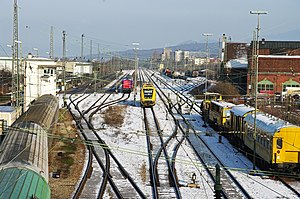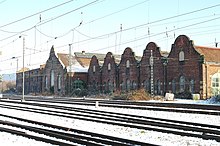Freiburg (Breisgau) freight yard
| Freiburg (Breisgau) freight yard | |
|---|---|
|
Rail network of the Freiburg freight station
|
|
| Data | |
| Operating point type | Freight depot |
| Location in the network | Intermediate station |
| abbreviation | RFG |
| opening | 1905 |
| location | |
| City / municipality | Freiburg in Breisgau |
| Place / district | Brühl (Freiburg im Breisgau) |
| country | Baden-Württemberg |
| Country | Germany |
| Coordinates | 48 ° 0 '39 " N , 7 ° 50' 54" E |
| Railway lines | |
| Railway stations in Baden-Württemberg | |
The Freiburg (Breisgau) Güterbahnhof train station is a freight yard in Freiburg im Breisgau . It was built between 1901 and 1905 to separate the freight traffic of the Freiburg main station , since it was no longer able to cope with the drastically increased turnover.
Location and connection
The station is connected to the rail network via the two-lane, eleven-kilometer freight bypass line between Gundelfingen and Leutersberg .
The railway line to Breisach is reached via the Heidenhof junction, whose turning track can also be used to drive the Höllentalbahn . When the Höllentalbahn was in 50-Hertz test operation between 1955 and 1960, freight trains for this route were continuously hauled by steam locomotives so that they did not have to switch to 50-Hertz locomotives at the main station.
The listed Lokhalle has belonged to the two Freiburg project developers Lars Bargmann and Frank Böttinger since 2011. In the past, the building was also used for medium-sized events until this was prohibited for security reasons. The existence of the listed hall is assured, it was extensively renovated from 2011 to 2016. The state of Baden-Württemberg funded the renovation with a six-figure sum. The old customs yard is now being used again after renovation and the new campo novo student residence has been built.
history
Originally the freight yard in Stühlinger should have been built south of the main station. Triggered by massive protests in the population, it was later built in an undeveloped area that would later become the Brühl district .
During the First World War , a meter-gauge track connection for the tram was laid from today's Rennweg stop via Neulindenstrasse and Rampenstrasse to Zollhallenplatz, in order to transport the wounded to the numerous hospitals spread across the entire city . The trams intended for this purpose waited at the loading ramp there for the hospital trains to arrive . The railcars and sidecars could each carry twelve seriously wounded people lying on stretchers on boards laid across. After the First World War, the track through Neunlindenstraße served - in a shortened form - for many years to connect a former track warehouse to Kaiserstuhlstraße.
Another connection between the tram and the Grand Ducal Baden State Railways was established in the civilian part of the freight station. This track led from the terminal at the time, which was located at the confluence of Eichstetter Strasse and Waldkircher Strasse, into the freight yard to enable direct reloading. It existed until the early 1980s when the GT8K railcars were delivered to Freiburg via this - in some cases four -rail - track connection .
During the Second World War, the main train station and the marshalling yard were also targeted:
- November 27, 1944 : several main tracks hit and lines to Freiburg-Süd and Heidenhof junction closed after a bomb attack
- December 22, 1944: several tracks as well as entrances and exits damaged by bombs, shunting locomotive failed
- December 30, 1944: ammunition train exploded as a result of several bombs, traffic control building destroyed and communication lines interrupted
- January 15, 1945: Sections around the freight railway line closed after bombing
- February 8, 1945: major track damage, light lines destroyed, further minor damage from fighter-bomber attack
- February 13, 1945: one track damaged and 15 wagons destroyed or damaged by a combined attack with bombs and on-board weapons
The attacks in World War I, however, did not cause any significant damage.
The name Freiburg (Breisgau) freight yard was created in 1977 through the merging of freight handling and marshalling yard .
In the 1980s, the dismantling of the freight yard began. Track group B and the connections for Freiburg companies were dismantled. The former station area is now being built on. A creative park is now located in the locomotive hall, which was built between 1903 and 1905. It was made possible by the city administration, the FWTM , the Grünhof start-up center and the community of owners. Since a new district has now emerged there, where construction is still underway but many people are already living, there has been a district market on Thursday afternoon on Zollhallenplatz since March 28, 2019.
business
The handling of goods by rail has decreased significantly in recent decades, so that the freight station serves almost exclusively as a transfer point for the rolling road . Trains to and from Novara in Italy leave or arrive at the freight yard up to eleven times a day. The site is increasingly used as a location for medium-sized companies and as a venue for cultural events.
There is also a daily garbage train, consisting of a class 203 and several S-wagons with closed containers, from Freiburg to Heitersheim / Eschbach to the TREA waste incineration plant and back. The trains are reloaded at the Remondis yard at the freight yard and brought back to Freiburg in the evening.
Until the 2015/2016 timetable change, the single-wagon traffic trains EZ 44280 (Offenburg Gbf – Freiburg Gbf – Bantzenheim – Mulhouse-Ville) and EZ 44281 (Mulhouse-Ville – Bantzenheim – Freiburg Gbf – Offenburg Gbf) had scheduled treatment in Freiburg. The two trains now run directly via Strasbourg / Kehl.
The wagons from Neuchâtel and Kaiserstuhl, which were removed and provided in Freiburg, are now being driven to their respective destinations with a new pair of trains, EZ 55825 (Offenburg Gbf - Freiburg Gbf) and EZ 55825 (Freiburg Gbf - Offenburg Gbf). The wagons are then distributed there. The locomotive of the morning train from Offenburg does not stay in Freiburg, but drives back to Offenburg as Tfzf 67470. In the afternoon, a different locomotive than Tfzf 67472/67475 sets off from Offenburg to Freiburg to pick up the wagons. Furthermore, a train runs several times a week to the industrial area of Freiburg, which supplies some of the companies located there with material.
The old connecting curve to the Breisacher Bahn is used daily by the transfer trains to and from Breisach . Furthermore, the pair of transfer trains 55691/55690 runs daily to and from the connection to the university clinic in the winter months . This train, made up of one to three Fcas wagons , supplies the clinic's thermal power station with wood pellets . These services are provided by SWEG.
On Friday evening, a SWEG shunting locomotive that is in Freiburg during the week and haunts the trains to and from Neuchâtel and the clinic leaves Freiburg as Tfzf 77150 via Riegel-Malterdingen to Endingen. Every morning the second locomotive as Tfzf 77151 comes from Endingen to Freiburg to pick up the wagons from EK 55825 and distribute them at the Kaiserstuhl.
The connection of the Scharrgas company at the freight yard was served several times a week by the SWEG. Before it was dismantled, it was operated via the eastern group B (from the north), later it was done from the south via a newly laid track that branches off at the also new manual switch 92 from track 7 south, but which was shut down at the end of 2017. The siding is now also being dismantled.
The freight yard is controlled separately in two interdependent parts of the station , each of which has an electromechanical interlocking of type E43 / 50 (lamp monitoring); The dispatcher interlocking "FRF" in the South (commissioning 13 December 1956) and the switch interlocking guards "rn" in the north (start 1962). A track vacancy detection system is not available in the station. Since the end of the 1980s, a track change operation has been set up to and from Freiburg Süd and the Gundelfingen junction .
literature
- Georg Schmidt-Abels: North city images. Discoveries at the freight yard. In: Freiburger Almanach 58 (2007) , pp. 121–126
- Gerhard Greß: Freiburg transport hub and its surroundings in the fifties and sixties. EK-Verlag, Freiburg 1997, ISBN 3-88255-263-8 , p. 101 f.
Web links
Individual evidence
- ^ The renovation of the Freiburg passenger station. In: Second evening paper of the Freiburger Zeitung of July 20, 1927
- ↑ Eberhard Hübsch: The State Railways . in: Freiburg im Breisgau. The city and its buildings , HM Poppen & Sohn, Freiburg 1898.
- ↑ a b c camaraderie of locomotive personnel at the Freiburg depot: 140 years of the railway in Freiburg - Rheintalbahn, Freiburg im Breisgau 1985, p. 75
- ^ Albert Kuntzemüller : The Baden Railways 1840-1940, self-published by the Geographical Institutes of the Universities of Freiburg i. Br. And Heidelberg, Freiburg im Breisgau 1940, p. 120
- ↑ Hans-Wolfgang Scharf, Burkhard Wollny: The Höllentalbahn. From Freiburg to the Black Forest. Eisenbahn-Kurier-Verlag, Freiburg im Breisgau 1987, ISBN 3-88255-780-X ., Scharf / Wollny pp. 144-146
- ^ Freiburg: Freiburg: No culture in the locomotive hall: Dangerous neighbor - badische-zeitung.de. Retrieved June 14, 2014 .
- ^ Campo NOVO. (No longer available online.) Archived from the original on September 10, 2015 ; Retrieved September 18, 2015 .
- ↑ L. Werthmann (Ed.): The Freiburg hospitals in the Völkerkrieg: 1914/15 , Caristasverlag, Freiburg im Breisgau 1915, pp. 152–153
- ↑ Hans-Wolfgang Scharf, Burkhard Wollny: The Höllentalbahn. From Freiburg to the Black Forest. Eisenbahn-Kurier-Verlag, Freiburg im Breisgau 1987, ISBN 3-88255-780-X ., Scharf / Wollny pp. 128–129
- ^ Roger Chickering: The Great War and Urban Life in Germany: Freiburg, 1914-1918. Cambridge, UK: Cambridge University Press, 2007, ISBN 978-0-521-85256-2 , p. 99
- ↑ Fabian Vögtle (text) and Michael Bamberger (photos): The creative park in the Lokhalle is ready. Badische Zeitung, June 23, 2018, accessed on July 29, 2018 .
- ^ Anja Bochtler: Freiburg is getting a new district market. Badische Zeitung, March 27, 2019, accessed on March 28, 2019 .
- ^ RAlpin AG: With the Rolling Autobahn through Switzerland , timetable from January 1, 2010, accessed on January 10, 2010
- ^ Badische Seiten: Güterbahnhof Freiburg , last accessed on November 14, 2009



